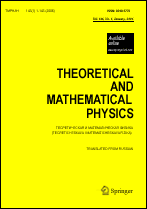|
|
Teoreticheskaya i Matematicheskaya Fizika, 1984, Volume 59, Number 3, Pages 323–344
(Mi tmf4993)
|
|
|
 |
This article is cited in 9 scientific papers (total in 9 papers)
Symmetry properties and dynamics in gauge theories with scalar fields
V. A. Matveev, A. N. Tavkhelidze, M. E. Shaposhnikov
Abstract:
The possibility of spontaneous breaking of the local and global
symmetries in gauge theories with scalar fields is discussed (as
usual, spontaneous symmetry breaking is taken to mean that
$[Q,H]=0$, $Q | \text{vac} \rangle\neq 0$, where $H$ is the
Hamiltonian and $Q$ is the generator of a gauge transformation).
It is shown that the standard assumption $\langle \varphi \rangle\neq
0$ in gauge theories does not mean that the symmetry is
spontaneously broken. It is shown that under certain conditions
the theory can be reformulated in terms of gauge-invariant
(“colorless”) local fields. An example is given of a theory of
eleetroweak interactions in which the occurrence of short-range
forces transmitted by massive vector bosons is entirely due to the
nonvanishing of the gauge-invariant order parameter of the vacuum
expectation vatue $\langle\varphi^+\varphi\rangle=\eta$ (of a scalar
condensate) and is not due to spontaneous breaking of the weak
isospin. The mass spectrum of particles in non-Abelian gauge
theories is analyzed in its dependence on the magnitude and sign
of the scalar condensate. It is shown that for $\eta\gg\Lambda^2$
($\Lambda$ is the reciprocal of the confinement radius) the
spectrum contains only colorless states, and the weak coupling
regime is realized, so that physical quantities can be calculated
by perturbation theory. In the ease of a small
$(|\eta|\ll\Lambda^2)$ or negahve $(\eta\sim-\Lambda^2)$ scalar
condensate, the strong coupling regime is realized in the system.
In QCD with massless scalar quarks in the ease
$\eta\sim-\Lambda^2$ the possible existence of a new family of
hadrons with masses of the order of several tens of GeV and
containing scalars is predicted.
Received: 02.02.1984
Citation:
V. A. Matveev, A. N. Tavkhelidze, M. E. Shaposhnikov, “Symmetry properties and dynamics in gauge theories with scalar fields”, TMF, 59:3 (1984), 323–344; Theoret. and Math. Phys., 59:3 (1984), 529–544
Linking options:
https://www.mathnet.ru/eng/tmf4993 https://www.mathnet.ru/eng/tmf/v59/i3/p323
|


|




 Contact us:
Contact us: Terms of Use
Terms of Use
 Registration to the website
Registration to the website Logotypes
Logotypes







 Citation in format
Citation in format 
